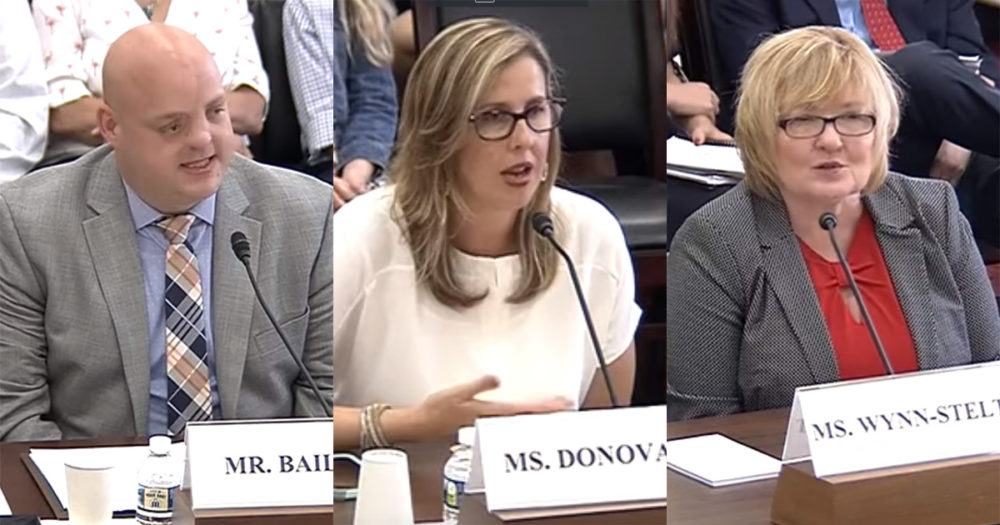The House Oversight and Reform Committee, Subcommittee on the Environment held a hearing this week titled, The Devil They Knew: PFAS Contamination and the Need for Corporate Accountability. The testimony of three people whose lives have been upended by exposure to PFAS chemicals was powerful and heart wrenching. DuPont and 3M should have been in the room. But seeing as they have been absent from communities except when legally compelled to be, they were not there to hear about the vast human cost they have caused by their suppression of science, stymieing of regulation, and foot-dragging on cleanup efforts.
The voices we heard had one thing in common: a company had polluted their water for decades and by the time they found out about it, the damage had already been done. Take Bucky Bailey, whose mom worked at DuPont’s Washington Works plant in Parkersburg, WV, and found out after giving birth to Bucky that PFAS exposure impacted his development in the womb. Take Emily Donovan from Brunswick County, NC, who found out in 2017 that DuPont/Chemours had been dumping the replacement PFAS, GenX, into the Cape Fear River since 1980 and listed off the many family members, friends, and neighbors that have developed health issues at young ages. Take Sandy Wynn-Stelt from Belmont, MI, who in 25 years of living in her home was never notified by the nearby tannery that it had used and dumped PFAS-containing Scotchgard onto nearby land for years and lost her husband to an aggressive form of cancer in 2016.
Some companies, when faced with knowledge and hard decisions about the dangers of their own products, turn to deceit and disinformation in order to keep conducting business as usual. Instead of shining a light on the science and notifying the public about known risks, PFAS manufacturers and users turned to page one of the Disinformation Playbook. Throughout the hearing, even though there were no industry representatives present as witnesses, the way in which that playbook has played out in communities was conspicuous.
The Disinformation Playbook in full effect
- The Fake: During the second panel, Dr. Jamie Dewitt, a scientist at East Carolina University who has been researching PFAS for 15 years, said that initially in her research she had trouble finding health studies on the class of PFAS chemicals. In her testimony, she refers to a 1978 study on immunotoxicity of PFOA that was not published and was only brought to the EPA’s attention in 2000 (more info on that in this paper). Decades later, we now know that 3M and DuPont knew about the human health risks associated with exposure to PFOA and PFOS as early as the 1950s. Instead of making these studies publicly available, they buried that evidence, and we are all paying the price of that decision.
- The Diversion: During questioning, Wynn-Stelt suggested to members of Congress not to get trapped in “analysis paralysis” when it comes to PFAS: If we see a link, we should act on it. That is exactly what the chemical industry does not want to hear. One of the industry’s favorite tactics is to play up uncertainty about a product’s harms in order to delay regulation. We have seen this play out with PFAS, where you won’t hear DuPont, 3M, or the American Chemistry Council explicitly say that the science is settled that PFAS are safe or unsafe. Instead, they will continue to point to the need for more research to remove every ounce of uncertainty even though in science there’s often not absolute certainty. The minority witness from the Lewis Brisbois law firm stuck to those talking points in her testimony, mentioning that: “States, federal agencies, and the scientific community are working vigorously to address PFAS issues against a backdrop of limited scientific knowledge, complexity, economic realities, and competing public health priorities.” States like Alaska, California, Minnesota, New Jersey, New Hampshire, Michigan, and Vermont have enacted or are working toward strong, enforceable standards based on the best available science—what’s EPA’s excuse?
Stop lying. Start fixing the problem.
At one point in the hearing, Representative Kildee from Michigan, who has been a champion of PFAS legislative solutions, asked all of the victims of PFAS contamination how their communities have changed since finding out about their tainted drinking water. Emily Donovan from North Carolina has noticed disturbing changes, like her local Parent Teacher Organization now asking for bottled water donations instead of baked goods, and she is now worried about her kids becoming dehydrated because they are afraid to drink water if it’s not bottled.
It is unacceptable that safe, accessible, and affordable water, which is a human right, is not a certainty in some communities. Not only that, but as Rep. Debbie Dingell brought up at the hearing, not all communities can afford the tax hikes required to do weekly or biweekly water testing for PFAS contamination and, as a result, don’t have the same access to vital water quality information that higher-income communities have. This is an environmental injustice. The companies that created this mess should be paying for water utilities to test for and filter out these chemicals, and to remove contamination from the source. One way of broaching this issue is by ensuring that PFAS are regulated as hazardous substances under the Superfund law. The House version of the NDAA that passed two weeks ago contains this amendment. We need this provision to make its way into the final version that ends up on the president’s desk.
Along with federal regulation, we need a commitment from the EPA and DOD that it will enforce these regulations. EPA’s enforcement numbers are at an all-time low, and now Peter Wright, a former Dow Chemical Company attorney with over 100 potential conflicts of interest just within the Superfund program at the Office of Land and Emergency Management, will be in charge of holding polluters responsible. This administration is failing our environment and public health in an effort to acquiesce to industry’s wishes. Wouldn’t it be great if industry led the way, owned up to its misdeeds, and offered to pay for its mess instead of placing that heavy economic burden on chemically-burdened families across the country? That’s what Bucky Bailey, Emily Donovan, Sandy Wynn-Stelt and so many other strong voices are calling for. The power of the people is growing, states are listening, and whether industry likes it or not, we are going to make them pay.

As a reminder of why industry needs to pay, agencies need to act, and Congress needs to do continued oversight, we should think about the next generation that will be continuing to deal with these forever chemicals. Wynn-Stelt pointed to the 22 children under the age of 13 in her community, calling on Congress to protect them. One little boy has levels of PFAS of over 500,000 ppt in his blood—over 7,000x the EPA’s health advisory. As a result of this exposure, his parents found that the vaccines he got as an infant were not effective—a well-studied immunological impact of PFAS exposure. We need action on PFAS, not lies and stonewalling, to protect this child and and give him and his peers the healthy future they deserve.

